| Maintenance Service Interval | Maintenance Procedure |
|---|---|
| Before each use or daily |
|
Introduction
This machine is a ride-on, reel-blade lawnmower intended to be used by professional, hired operators in commercial applications. It is primarily designed for cutting grass on well-maintained lawns in parks, golf courses, sports fields, and on commercial grounds. It is not designed for cutting brush, mowing grass and other growth alongside highways, or for agricultural uses.
Read this information carefully to learn how to operate and maintain your product properly and to avoid injury and product damage. You are responsible for operating the product properly and safely.
You may contact Toro directly at www.Toro.com for product and accessory information, help finding a dealer, or to register your product.
Whenever you need service, genuine Toro parts, or additional information, contact an Authorized Service Dealer or Toro Customer Service and have the model and serial numbers of your product ready. Figure 1 identifies the location of the model and serial numbers on the product. Write the numbers in the space provided.
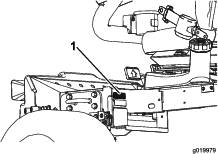
This manual identifies potential hazards and has safety messages identified by the safety alert symbol (Figure 2), which signals a hazard that may cause serious injury or death if you do not follow the recommended precautions.

This manual uses 2 words to highlight information. Important calls attention to special mechanical information and Note emphasizes general information worthy of special attention.
This product complies with all relevant European directives; for details, please see the separate product specific Declaration of Conformity (DOC) sheet.
Important: This engine is not equipped with a spark arrester muffler. It is a violation of California Public Resource Code Section 4442 to use or operate the engine on any forest-covered, brush-covered, or grass-covered land. Other states or federal areas may have similar laws.
Warning
CALIFORNIA
Proposition 65 Warning
Diesel engine exhaust and some of its constituents are known to the State of California to cause cancer, birth defects, and other reproductive harm.
Safety
This machine has been designed in accordance with EN ISO 5395:2013 (when appropriate decals are applied) and ANSI B71.4-2012.
Improperly using or maintaining the machine can result in injury. To reduce the potential for injury, comply with these safety instructions and always pay attention to the safety alert symbol, which means Caution, Warning, or Danger—personal safety instruction. Failure to comply with the instruction may result in personal injury or death.
Safe Operating Practices
Training
-
Read the Operator’s Manual and other training material carefully. Be familiar with the controls, safety signs, and the proper use of the equipment.
-
If the operator or mechanic can not read the language of this manual, it is the owner’s responsibility to explain this material to them.
-
Never allow children or people unfamiliar with these instructions to use or service the mower. Local regulations may restrict the age of the operator.
-
Never mow while people, especially children, or pets are nearby.
-
Keep in mind that the operator or user is responsible for accidents or hazards occurring to other people or their property.
-
Do not carry passengers.
-
All drivers and mechanics should seek and obtain professional and practical instruction. The owner is responsible for training the users. Such instruction should emphasize the following:
-
The need for care and concentration when working with ride-on machines
-
Control of a ride-on machine sliding on a slope will not be regained by the application of the brake. The main reasons for loss of control are as follows:
-
Insufficient wheel grip
-
Being driven too fast
-
Inadequate braking
-
The type of machine is unsuitable for the task
-
Lack of awareness of the effect of ground conditions, especially slopes
-
Incorrect hitching and load distribution
-
-
Preparation
-
While mowing, always wear substantial, slip-resistant footwear, long trousers, hard hat, safety glasses, and hearing protection. Long hair, loose clothing, or jewelry may get tangled in moving parts. Do not operate the equipment when barefoot or wearing open sandals.
-
Thoroughly inspect the area where the equipment is to be used and remove all objects which may be thrown by the machine.
-
Replace faulty silencers/mufflers.
-
Evaluate the terrain to determine what accessories and attachments are needed to properly and safely perform the job. Only use accessories and attachments approved by the manufacturer.
-
Check that operator’s presence controls, safety switches and shields are attached and functioning properly. Do not operate unless they are functioning properly.
Operation
-
Do not operate the engine in a confined space where dangerous carbon monoxide and other exhaust gasses can collect.
-
Mow only in daylight or in good artificial light.
-
Before attempting to start the engine, disengage all blade attachment clutches, shift into neutral, and engage the parking brake. Only start the engine from the operator’s position. Never remove the ROPS and always wear the seat belts during operation.
-
Do not put hands or feet near or under rotating parts. Keep clear of the discharge opening at all times.
-
Remember there is no such thing as a safe slope. Travel on grass slopes requires particular care. Do the following to guard against overturning:
-
Do not stop or start suddenly when going up or downhill.
-
Keep machine speeds low on slopes and during tight turns.
-
Stay alert for humps and hollows and other hidden hazards.
-
Never mow across the face of the slope, unless the mower is designed for this purpose.
-
-
Stay alert for holes in the terrain and other hidden hazards.
-
Watch out for traffic when crossing or near roadways.
-
Stop the blades from rotating before crossing surfaces other than grass.
-
When using any attachments, never direct discharge of material toward bystanders nor allow anyone near the machine while in operation.
-
Never operate the machine with damaged guards, shields, or without safety protective devices in place. Be sure all interlocks are attached, adjusted properly, and functioning properly.
-
Do not change the engine governor settings or overspeed the engine. Operating the engine at excessive speed may increase the hazard of personal injury.
-
Do the following before leaving the operator’s position:
-
Stop on level ground.
-
Disengage the power take-off and lower the attachments.
-
Change into neutral and set the parking brake.
-
Stop the engine and remove the key.
-
-
Disengage the drive to attachments, stop the engine, and remove the ignition key in the following conditions:
-
Before making height adjustments, unless the adjustment can be made from the operator’s position.
-
Before clearing blockages
-
Before checking, cleaning, or working on the mower
-
After striking a foreign object or if an abnormal vibration occurs (check immediately). Inspect the cutting units for damage and make repairs before restarting and operating the equipment.
-
-
Disengage the drive to attachments when transporting or when not machine is not in use.
-
Stop the engine and disengage the drive to attachments before the following:
-
Refueling
-
Making height adjustment, unless the adjustment can be made from the operator's position
-
-
Reduce the throttle setting before stopping the engine and, if the engine is provided with a fuel shut-off valve, turn the fuel off at the conclusion of mowing.
-
Never raise the cutting units with the reels running.
-
Keep hands and feet away from the cutting units.
-
Look behind and down before backing up to be sure of a clear path.
-
Slow down and use caution when making turns and crossing roads and sidewalks.
-
Do not operate the mower under the influence of alcohol or drugs.
-
Lightning can cause severe injury or death. If lightning is seen or thunder is heard in the area, do not operate the machine; seek shelter.
-
Use care when loading or unloading the machine into a trailer or truck.
-
The operator shall turn on flashing warning lights, if provided, whenever traveling on a public road, except where such use is prohibited by law.
Rollover Protection System (ROPS)—Use and Maintenance
-
The ROPS is an integral and effective safety device. Keep a folding ROPS in the raised and locked position and use the seat belt when operating the machine.
-
Lower a folding ROPS temporarily only when absolutely necessary. Do not wear the seat belt when folded down.
-
Be aware there is no rollover protection when a folded ROPS is in the down position.
-
Be certain that the seat belt can be released quickly in the event of an emergency.
-
Check the area to be mowed and never fold down a folding ROPS in areas where there are slopes, drop offs or water.
-
Check carefully for overhead clearances (i.e. branches, doorways, electrical wires) before driving under any objects and do not contact them.
-
Keep the ROPS in safe operating condition by periodically thoroughly inspecting for damage and keeping all mounting fasteners tight.
-
Replace a damaged ROPS. Do not repair or revise.
-
Do not remove the ROPS.
-
Any alterations to a ROPS must be approved by the manufacturer.
Safe Handling of Fuels
-
To avoid personal injury or property damage, use extreme care in handling gasoline. Gasoline is extremely flammable and the vapors are explosive.
-
Extinguish all cigarettes, cigars, pipes, and other sources of ignition.
-
Use only an approved fuel container.
-
Never remove fuel cap or add fuel with the engine running.
-
Allow engine to cool before refueling.
-
Never refuel the machine indoors.
-
Never store the machine or fuel container where there is an open flame, spark, or pilot light such as on a water heater or on other appliances.
-
Never fill containers inside a vehicle or on a truck or trailer bed with a plastic liner. Always place containers on the ground away from your vehicle before filling.
-
Remove equipment from the truck or trailer and refuel it on the ground. If this is not possible, then refuel such equipment with a portable container, rather than from a fuel dispenser nozzle.
-
Keep the nozzle in contact with the rim of the fuel tank or container opening at all times until fueling is complete.
-
Do not use a nozzle lock open device.
-
If fuel is spilled on clothing, change clothing immediately.
-
Never overfill fuel tank. Replace fuel cap and tighten securely.
Maintenance and Storage
-
Keep all nuts, bolts and screws tight to be sure the equipment is in safe working condition.
-
Never store the equipment, with fuel in the tank, inside a building where fumes may reach an open flame or spark.
-
Allow the engine to cool before storing in any enclosure.
-
To reduce the fire hazard, keep the engine, silencer/muffler, battery compartment fuel storage area, cutting units and drives free of grass, leaves, or excessive grease. Clean up oil or fuel spillage.
-
Replace worn or damaged parts for safety.
-
If the fuel tank has to be drained, do this outdoors.
-
When machine is to be parked, stored, or left unattended, lower the cutting units unless a positive mechanical lock is provided.
-
Disengage drives, lower the cutting units, set parking brake, stop engine and remove key. Wait for all movement to stop before adjusting, cleaning or repairing.
-
Shut off fuel while storing or transporting. Do not store fuel near flames.
-
Park the machine on level ground. Never allow untrained personnel to service machine.
-
Use jack stands to support components when required.
-
Carefully release pressure from components with stored energy.
-
Disconnect battery before making any repairs. Disconnect the negative terminal first and the positive last. Reconnect positive first and negative last.
-
Keep hands and feet away from moving parts. If possible, do not make adjustments with the engine running.
-
Charge batteries in an open well ventilated area, away from spark and flames. Unplug charger before connecting or disconnecting from battery. Wear protective clothing and use insulated tools.
Hauling
-
Use care when loading or unloading the machine into a trailer or truck.
-
Use full width ramps for loading machine into trailer or truck.
-
Tie the machine down securely using straps, chains, cable, or ropes. Both front and rear straps should be directed down and outward from the machine.
Toro Mower Safety
The following list contains safety information specific to Toro products or other safety information that you must know that is not included in the CEN, ISO, or ANSI standards.
This product is capable of amputating hands and feet and throwing objects. Always follow all safety instructions to avoid serious injury or death.
Use of this product for purposes other than its intended use could prove dangerous to user and bystanders.
Warning
Engine exhaust contains carbon monoxide, which is an odorless, deadly poison that can kill you. Do not run engine indoors or in an enclosed area.
Preparation
Be sure to establish your own special procedures and work rules for unusual operating conditions (e.g., slopes too steep for operation). Survey the complete mowing site to determine which hills can be safely operated on. When performing this site survey, always use common sense and take into consideration the turf condition and the rollover risk. To determine which hills or slopes may be safely operated on, use the slope chart provided in the manual. To perform a site survey, follow the procedure outlined in the Operation section of the this manual. The maximum side hill angle is detailed on the slope decal affixed on the machine.
Training
The operator must be skilled and trained in how to drive on hillsides. Failure to use caution on slopes or hills may cause the vehicle to tip or roll, possibly resulting in personal injury or death.
Operation
-
Know how to stop the machine and engine quickly.
-
Do not operate the machine while wearing tennis shoes or sneakers.
-
Wearing safety shoes and long pants is advisable and required by some local ordinances and insurance regulations.
-
Keep hands, feet, and clothing away from moving parts and the mower discharge area.
-
Fill the fuel tank until level is 1/2 inch (12 mm) below the bottom of the filler neck. Do not overfill.
-
Check the safety interlock switches daily for proper operation. If a switch should fail, replace the switch before operating the machine.
-
When starting the engine, engage the parking brake, put the traction pedal in neutral, and disengage the blade drive. After the engine starts, release the parking brake and keep your foot off of the traction pedal. The machine must not move. If movement is evident, refer to the Maintenance section of this manual to adjust the traction drive.
-
Use extreme caution when operating close to sand traps, ditches, creeks, steep hillsides, or other hazards.
-
Reduce speed when making sharp turns.
-
Do not turn on hills.
-
Do not operate on a side hill that is too steep. A rollover may occur before losing traction.
-
The slope angle at which the machines will tip is dependent on many factors. Among these are mowing conditions such as wet or undulating terrain, speed (especially in turns), position of the cutting units (up or down), tire pressure, and operator experience. At side hill angles of 20 degrees or less, the risk of a rollover is low. As the slope angle increases to a recommended maximum limit of 25 degrees, the risk of a rollover increases to a moderate level. Do not exceed a 25 degree side hill slope angle because the risk of a rollover and serious injury or death is very high.
-
For steering control, lower the cutting units when going down slopes.
-
Avoid sudden stops and starts.
-
Use the reverse pedal for braking.
-
Watch for traffic when near or crossing roads. Always yield the right-of-way.
-
Raise the cutting units when driving from one work area to another.
-
Do not touch the engine, muffler, exhaust pipe, or hydraulic tank while the engine is running or soon after it has stopped because these areas could be hot enough to cause burns.
-
This machine is not designed or equipped for on-road use and is a slow-moving vehicle. If you must cross or travel on a public road, you should be aware of and comply with local regulations, such as required lights, slow moving vehicle signs, and reflectors.
Maintenance and Storage
-
Before servicing or making adjustments, stop the engine and remove the ignition key.
-
Ensure that the entire machine is properly maintained and in good operating condition. Frequently check all nuts, bolts, screws, and hydraulic fittings.
-
Make sure all hydraulic line connectors are tight and all hydraulic hoses and lines are in good condition before applying pressure to the system.
-
Keep your body and hands away from pin hole leaks or nozzles that eject hydraulic fluid under high pressure. Use paper or cardboard, not your hands, to search for leaks. Hydraulic fluid escaping under pressure can have sufficient force to penetrate the skin and cause serious injury. If fluid is injected into the skin it must be surgically removed within a few hours by a doctor familiar with this form of injury or gangrene may result.
-
Before disconnecting or performing any work on the hydraulic system, all pressure in the system must be relieved by stopping the engine and lowering the cutting units to the ground.
-
If the engine must be running to perform a maintenance adjustment, keep hands, feet, clothing, and any parts of the body away from the cutting units, attachments, and any moving parts. Keep everyone away.
-
Do not overspeed the engine by changing governor settings. To ensure safety and accuracy, have an Authorized Toro Distributor check the maximum engine speed with a tachometer.
-
The engine must be shut off before checking the oil or adding oil to the crankcase.
-
If major repairs are ever needed or if assistance is desired, contact an Authorized Toro Distributor.
-
To ensure optimum performance and continued safety certification of the machine, use only genuine Toro replacement parts and accessories. Replacement parts and accessories made by other manufacturers could be dangerous, and such use could void the product warranty.
Sound Power Level
This unit has a guaranteed sound power level of 101 dBA, which includes an Uncertainty Value (K) of 1 dBA.
Sound power level was determined according to the procedures outlined in ISO 11094.
Sound Pressure Level
This unit has a sound pressure level at the operator’s ear of 85 dBA, which includes an Uncertainty Value (K) of 1 dBA.
Sound pressure level was determined according to the procedures outlined in EN ISO 5395:2013.
Vibration Level
Hand-Arm
Measured vibration level for right hand = 0.28 m/s2
Measured vibration level for left hand = 0.26 m/s2
Uncertainty Value (K) = 0.14 m/s2
Measured values were determined according to the procedures outlined in EN ISO 5395:2013.
Whole Body
Measured vibration level = 0.2 m/s2
Uncertainty Value (K) = 0.1 m/s2
Measured values were determined according to the procedures outlined in EN ISO 5395:2013.
Safety and Instructional Decals
 |
Safety decals and instructions are easily visible to the operator and are located near any area of potential danger. Replace any decal that is damaged or lost. |

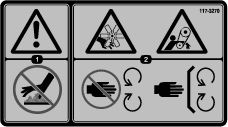



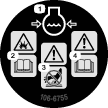


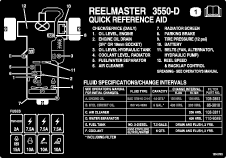
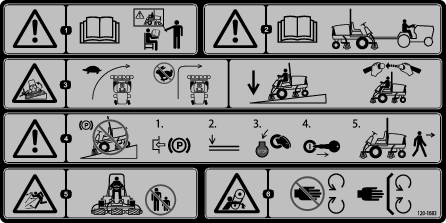

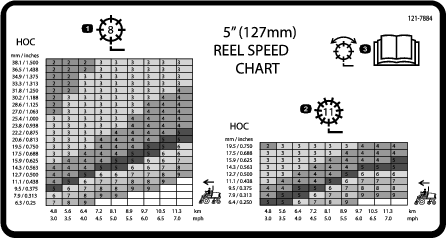
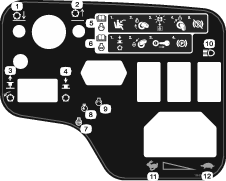

Setup
Note: Determine the left and right sides of the machine from the normal operating position.
Installing the Cutting Units
-
Remove the reel motors from the shipping brackets.
-
Remove the shipping brackets and discard.
-
Remove the cutting units from the cartons. Assemble and adjust as described in the cutting unit Operator's Manual.
-
Make sure that the counterweight (Figure 3) is installed to the proper end of the cutting unit as described in the cutting unit Operator's Manual.
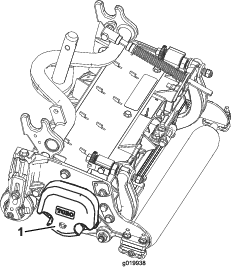
-
All the cutting units are shipped with the turf compensation spring mounted to the right side of the cutting unit. The turf compensation spring must be mounted to the same side of the cutting unit as the reel drive motor. Reposition the turf compensation as follows:
-
Remove the 2 carriage bolts and nuts securing the rod bracket to the cutting unit tabs (Figure 4).

-
Remove the flange nut securing the spring tube bolt to the carrier frame tab (Figure 4), and remove the assembly.
-
Mount the spring tube bolt to the opposite tab on the carrier frame and secure it with the flange nut.
Note: Position the bolt head to the outer side of the tab as shown in Figure 4.

-
Mount the rod bracket to the cutting unit tabs with the carriage bolts and nuts (Figure 5).
Note: When installing or removing the cutting units, make sure that the hairpin cotter is installed in the spring rod hole next to the rod bracket. Otherwise, the hairpin cotter must be installed in the hole in the end of the rod.
-
-
Lower all the lift arms completely.
-
Remove the snapper pin and the cap from the lift-arm pivot yoke (Figure 6).
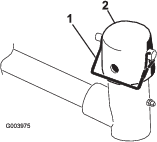
-
For the front cutting units, slide a cutting unit under the lift arm while inserting the carrier frame shaft up into the lift-arm pivot yoke (Figure 7).
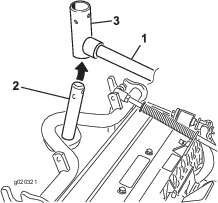
-
Use the following procedure on the rear cutting units when the height of cut is above 1.2 cm (3/4 inch).
-
Remove the lynch pin and washer securing the lift-arm pivot shaft to the lift arm and slide the lift-arm pivot shaft out of the lift arm (Figure 8).
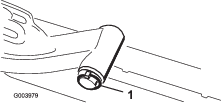
-
Insert the lift-arm yoke onto the carrier frame shaft (Figure 7).
-
Insert the lift-arm shaft into the lift arm and secure it with the washer and lynch pin (Figure 8).
-
-
Insert the cap over the carrier frame shaft and lift-arm yoke.
-
Secure the cap and the carrier frame shaft to the lift-arm yoke with the snapper pin.
Note: Use the slot if a steering cutting unit is desired or use the hole if the cutting unit is to be locked in position (Figure 6).
-
Secure the lift-arm chain to the chain bracket with the snapper pin (Figure 9).
Note: Use the number of chain links specified in the cutting unit Operator's Manual.
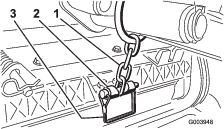
-
Coat the spline shaft of the reel motor with clean grease.
-
Oil the reel-motor O-ring and install it onto the motor flange.
-
Install the motor by rotating it clockwise so that the motor flanges clear the locknuts (Figure 10). Rotate the motor counterclockwise until the flanges encircle the nuts then tighten the nuts.
Important: Make sure that the reel motor hoses are not twisted, kinked, or at risk of being pinched.
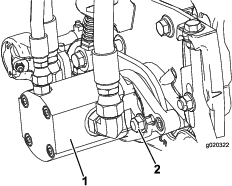
Adjusting the Turf Compensation Spring
The turf compensation spring (Figure 11) transfers weight from the front to the rear roller. This helps to reduce a wave pattern in the turf, also known as marcelling or bobbing.
Important: Make spring adjustments with the cutting unit mounted to the traction unit, pointing straight ahead and lowered to the shop floor.
-
Make sure that the hairpin cotter is installed in the rear hole in the spring rod (Figure 11).
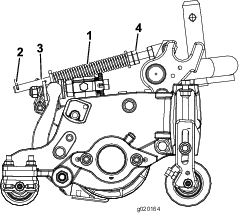
-
Tighten the hex nuts on the front end of the spring rod until the compressed length of the spring (Figure 11) is 12.7 cm (5 inches).
Note: When operating on rough terrain, decrease the spring length by 2.5 cm (1/2 inch). Ground following will be slightly decreased.
Installing the CE Decal
Parts needed for this procedure:
| Warning decal (120-1686) | 1 |
If this machine will be used for CE, affix the warning decal 120-1686 over English warning decal 120-1683.
Installing the Hood Latch (CE only)
Parts needed for this procedure:
| Lock bracket | 1 |
| Rivet | 2 |
| Washer | 1 |
| Screw, 1/4 x 2 inches | 1 |
| Locknut, 1/4 inch | 1 |
-
Unhook the hood latch from the hood-latch bracket.
-
Remove the (2) rivets securing the hood-latch bracket to the hood (Figure 12) and remove the hood-latch bracket from the hood.
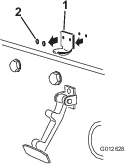
-
While aligning the mounting holes, position the CE lock bracket and the hood-latch bracket onto the hood.
Note: The lock bracket must be against the hood (Figure 13). Do not remove the bolt and nut assembly from the lock-bracket arm.
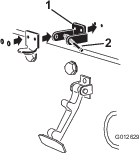
-
Align the washers with the holes on the inside of the hood.
-
Rivet the brackets and the washers to the hood (Figure 13).
-
Hook the latch onto the hood-latch bracket (Figure 14).
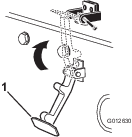
-
Screw the bolt into the other arm of the hood-lock bracket to lock the latch in position (Figure 15).
Note: Tighten the bolt securely but do not tighten the nut.
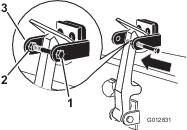
Using the Cutting Unit Kickstand
Parts needed for this procedure:
| Cutting unit kickstand | 1 |
Whenever the cutting unit has to be tipped to expose the bedknife/reel, prop up the rear of the cutting unit with the kickstand to make sure that the nuts on the back end of the bedbar adjusting screws are not resting on the work surface (Figure 16).
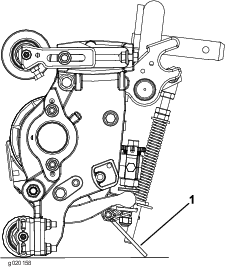
Secure the kickstand to the chain bracket with the snapper pin (Figure 17).
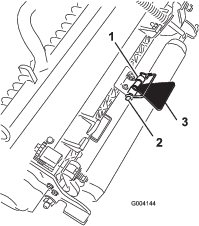
Product Overview
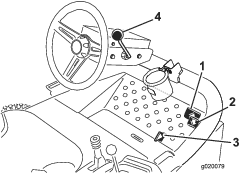
Traction Pedals
Mow/Transport Slide
Using your heel, move the mow/transport slide (Figure 18) to the left to transport and to the right to mow. The cutting units will only operate in the mow position and not lower in the transport position.
Important: The mow speed is set at the factory to 9.7 km/h (6 mph). It can be increased or decreased by adjusting the speed stop screw (Figure 19).

Tilt-Steering Lever
Pull the tilt-steering lever (Figure 18) back to tilt the steering wheel to the desired position. Then push the lever forward to secure the position.
Ignition Switch
The ignition switch (Figure 20), used to start, stop, and preheat the engine, has 3 positions: Off, On/Preheat, and Start. Rotate the key to the On/Preheat position until the glow-plug indicator light goes out (approximately 7 seconds); then rotate the key to the Start position to engage the starter motor. Release the key when the engine starts. The key will move automatically to the On/Run position. To shut the engine off, rotate the key to the Off position. Remove the key from the switch to prevent accidental starting.
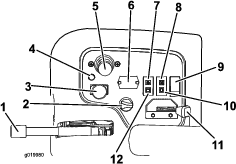
Throttle
Move the throttle (Figure 20) forward to increase the engine speed and rearward to decrease the engine speed.
Enable/Disable Switch
Use the enable/disable switch (Figure 20) in conjunction with the lower mow/raise control lever to operate the cutterheads. The cutting units cannot be lowered when the mow/transport lever is in the transport position.
Hour Meter
The hour meter (Figure 20) indicates the total hours of machine operation. The hour meter starts to function whenever the key switch is On.
Lower Mow/Raise Control Lever
This lever (Figure 20) raises and lowers the cutting units and also starts and stops the cutterheads when the cutterheads are enabled in the mow mode. The cutting units cannot be lowered when the mow/transport lever is in the transport position.
Note: When the cutting units re enabled, the lever does not have to be held in the forward position while the cutting units are lowered or raised.
Engine Coolant Temperature Warning Light
The temperature warning light (Figure 20) glows if the engine coolant temperature is high. The cutting units will disable, if the traction unit is not stopped and the coolant temperature rises another 10° F, the engine will kill.
Oil-Pressure Warning Light
The oil-pressure warning light (Figure 20) glows if the engine oil pressure drops below a safe level.
Alternator Light
The alternator light (Figure 20) should be off when the engine is running. If it is on, the charging system should be checked and repaired as necessary.
Glow-Plug Indicator
The glow-plug indicator light (Figure 20) will glow when the glow plugs are operating.
Parking Brake
Whenever the engine is shut off, engage the parking brake (Figure 20) to prevent accidental movement of the machine. To engage the parking brake, pull up on the lever. The engine will stop if you press the traction pedal with the parking brake engaged.
Diagnostic Light
The diagnostic light (Figure 20) will illuminate should a system fault be recognized.
Fuel Gauge
The fuel gauge (Figure 21) registers the amount of fuel in the tank.
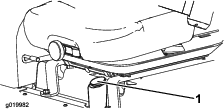
Power Point
The power point, located on the outside of the control panel, is a 12-volt power supply for electronic devices (Figure 22).
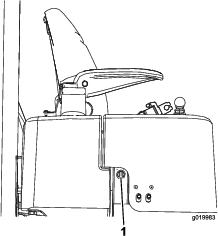
Reel Speed Control Knob
Backlap Lever
Use the backlap lever in conjunction with the lower mow/raise control lever for the reels (Figure 23).
Note: Specifications and design are subject to change without notice.
| Width of Cut | 208 cm (82 inches) |
| Overall Width | 239 cm (94 inches) |
| Transport Width | 231 cm (91 inches) |
| Overall Length | 295 cm (110 inches) |
| Height to top of ROPS | 188 cm (74 inches) |
| Wheel Base | 151 cm (59.5 inches) |
| Weight with 18 inch, 8 blade cutting units | 900 kg (1985 lb) |
| Weight without cutting units | 708 kg (1560 lb) |
Attachments/Accessories
A selection of Toro approved attachments and accessories is available for use with the machine to enhance and expand its capabilities. Contact your Authorized Service Dealer or Distributor or go to www.Toro.com for a list of all approved attachments and accessories.
Operation
Note: Determine the left and right sides of the machine from the normal operating position.
Checking the Engine-Oil Level
The engine is shipped with oil in the crankcase; however, the oil level must be checked before and after the engine is first started.
Crankcase capacity is approximately 3.8 L (4 US qt) with the filter.
Use high-quality engine oil that meets the following specifications:
-
API Classification Level Required: CH-4, CI-4 or higher.
-
Preferred oil: SAE 15W-40 (above 0ºF (-17ºC))
-
Alternate oil: SAE 10W-30 or 5W-30 (all temperatures)
Note: Toro Premium Engine oil is available from your distributor in either 15W-40 or 10W-30 viscosity. Refer to the parts catalog for part numbers.
Note: The best time to check the engine oil is when the engine is cool before it has been started for the day. If it has already been run, allow the oil to drain back down to the sump for at least 10 minutes before checking. If the oil level is at or below the “add” mark on the dipstick, add oil to bring the oil level to the “full” mark. Do not overfill the engine. If the oil level is between the “full” and “add” marks, no oil addition is required.
-
Position the machine on a level surface.
-
Remove the dipstick (Figure 24) and wipe it with a clean rag.
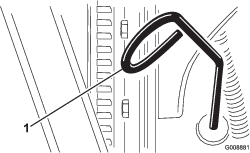
-
Push the dipstick down into the dipstick tube and make sure that it is seated fully. Pull the dipstick out and check the oil level.
-
If the oil level is low, remove the oil-fill cap (Figure 25) and gradually add small quantities of oil, checking the level frequently, until the level reaches the Full mark on the dipstick.
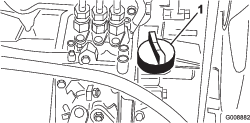
-
Install the oil-fill cap and close the hood.
Filling the Fuel Tank
Use only clean, fresh diesel fuel or biodiesel fuels with low (<500 ppm) or ultra low (<15 ppm) sulfur content. The minimum cetane rating should be 40. Purchase fuel in quantities that can be used within 180 days to ensure fuel freshness.
The fuel tank capacity is approximately 42 liters (11 US gallons).
Use summer-grade diesel fuel (Number 2-D) at temperatures above -7°C (20°F) and winter-grade diesel fuel (Number 1-D or Number 1-D/2-D blend) below -7°C (20°F ). Use of winter grade fuel at lower temperatures provides lower flash point and cold flow characteristics which will ease starting and reduce fuel filter plugging.
Use of summer grade fuel above -7 degrees C (20 degrees F) will contribute toward longer fuel pump life and increased power compared to winter grade fuel.
Biodiesel Ready
This machine can also use a biodiesel blended fuel of up to B20 (20% biodiesel, 80% petrodiesel). The petrodiesel portion should be low or ultra-low sulfur. Observe the following precautions:
-
The biodiesel portion of the fuel must meet specification ASTM D6751 or EN14214.
-
The blended fuel composition should meet ASTM D975 or EN590.
-
Painted surfaces may be damaged by biodiesel blends.
-
Use B5 (biodiesel content of 5%) or lesser blends in cold weather
-
Monitor seals, hoses, gaskets in contact with fuel as they may be degraded over time.
-
Fuel filter plugging may be expected for a time after converting to biodiesel blends.
-
Contact your distributor if you wish for more information on biodiesel
-
Clean the area around the fuel-tank cap (Figure 26).
-
Remove the fuel tank cap.
-
Fill the tank to the bottom of the filler neck. Do not overfill the tank. Install the cap.
-
To prevent a fire hazard, wipe up any fuel that may have spilled.

Danger
Under certain conditions, diesel fuel and fuel vapors are highly flammable and explosive. A fire or explosion from fuel can burn you and others and can cause property damage.
-
Use a funnel and fill the fuel tank outdoors, in an open area, when the engine is off and is cold. Wipe up any fuel that spills.
-
Do not fill the fuel tank completely full. Add fuel to the fuel tank until the level is 6 to 13 mm (1/4 to 1/2 inch) below the bottom of the filler neck. This empty space in the tank allows the fuel to expand.
-
Never smoke when handling fuel, and stay away from an open flame or where fuel fumes may be ignited by a spark.
-
Store fuel in a clean, safety-approved container and keep the cap in place.
-
Checking the Cooling System
| Maintenance Service Interval | Maintenance Procedure |
|---|---|
| Before each use or daily |
|
Clean debris off of the radiator/oil cooler daily (Figure 27). Clean the radiator/oil cooler hourly if conditions are extremely dusty and dirty; refer to Cleaning the Engine Cooling System.
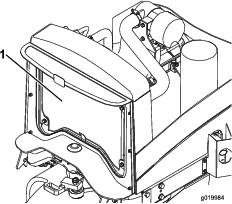
The cooling system is filled with a 50/50 solution of water and permanent ethylene glycol anti-freeze. Check the coolant level at the beginning of each day before starting the engine.
The capacity of the cooling system is approximately 5.7 L (6 US qt).
Caution
If the engine has been running, the pressurized, hot coolant can escape and cause burns.
-
Do not open the radiator cap when the engine is running.
-
Use a rag when opening the radiator cap, and open the cap slowly to allow steam to escape.
-
Check the coolant level in the expansion tank (Figure 28). With a cold engine, the coolant level should be approximately midway between the marks on the side of the tank.
-
If the coolant level is low, remove the expansion-tank cap and replenish the system. Do not overfill the tank.
-
Install the expansion-tank cap.
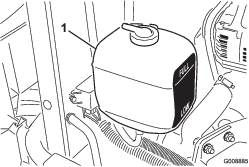
Checking the Hydraulic System
| Maintenance Service Interval | Maintenance Procedure |
|---|---|
| Before each use or daily |
|
The reservoir is filled at the factory with approximately 13.2 liters (3.5 US gallons) of high-quality hydraulic fluid. The best time to check the hydraulic oil is when the fluid is cold. The machine should be in its transport configuration. If the oil level is below the ‘add’ mark on the dipstick, add oil to bring the oil level to the middle of the acceptable range. Do not overfill the reservoir. If the oil level is between the ‘full’ and the ‘add’ marks, no oil addition is required.
The recommended replacement fluid is:
Toro Premium All Season Hydraulic Fluid
(available in 19 liter (5 gallon) containers or 208 liter (55 gallon) drums—see the parts documentation or your Toro distributor for part numbers)
Alternative fluids: If the Toro fluid is not available, other conventional, petroleum-based fluids may be used, provided that they meet all of the following material properties and industry specifications. Check with your oil supplier to see whether the oil meets these specifications.
Note: Toro will not assume responsibility for damage caused by improper substitutions, so use only products from reputable manufacturers who will stand behind their recommendation.
| High Viscosity Index/Low Pour Point Antiwear Hydraulic Fluid, ISO VG 46 Multigrade | |||
| Material Properties: | |||
| Viscosity, ASTM D445 | cSt @ 40°C (104°F) 44 to 48cSt @ 100°C (212°F) 7.9 to 9.1 | ||
| Viscosity index, ASTM D2270 | 140 or higher (high viscosity index indicates a multiweight fluid) | ||
| Pour point, ASTM D97 | -36.7°C to -45°C (-34°F to -49°F) | ||
| FZG, fail stage | 11 or better | ||
| Water content (new fluid) | 500 ppm (maximum) | ||
| Industry Specifications: | |||
| Vickers I-286-S, Vickers M-2950-S, Denison HF-0, Vickers 35 VQ 25 (Eaton ATS373-C) | |||
The proper hydraulic fluids must be specified for mobile machinery (as opposed to industrial plant usage), multiweight-type, with ZnDTP or ZDDP anti-wear additive package (not an ashless-type fluid).
Important: Many hydraulic fluids are almost colorless, making it difficult to spot leaks. A red dye additive for the hydraulic system oil is available in 20 ml (2/3 fl oz) bottles. One bottle is sufficient for 15 to 22liters (4 to 6 US gallons) of hydraulic oil. Order part 44-2500 from your Authorized Toro Distributor.
Synthetic, Biodegradable Hydraulic Fluid
(available in 19 liter (5 gallon) containers or 208 liter (55 gallon) drums—see the parts documentation or your Toro distributor for part numbers)
This high-quality, synthetic, biodegradable fluid has been tested and found compatible for this Toro model. Other brands of synthetic fluid may have seal compatibility problems and Toro cannot assume responsibility for unauthorized substitutions.
Note: This synthetic fluid is not compatible with the Toro Biodegradable Fluid previously sold. See your Toro Distributor for more information.
Alternative fluids:
-
Mobil EAL Envirosyn H 46 (US)
-
Mobil EAL Hydraulic Oil 46 (international)
-
Position the machine on a level surface, lower the cutting units, and stop the engine.
-
Clean the area around the filler neck and cap of the hydraulic tank (Figure 29). Remove the cap.
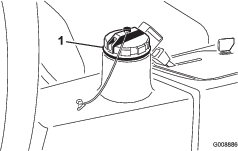
-
Remove the dipstick from the filler neck and wipe it with a clean rag. Insert the dipstick into the filler neck; then remove it and check the fluid level. The fluid level should be within 6 mm (1/4 inch) of the mark on the dipstick.
-
If the level is low, add the appropriate fluid to raise the level to the full mark.
-
Install the dipstick and cap onto the filler neck.
Checking the Reel-to-Bedknife Contact
Each day before operating, check the reel-to-bedknife contact, regardless of whether the quality of cut had previously been acceptable. There must be light contact across the full length of the reel and the bedknife (refer to Adjusting the Reel to Bedknife in the cutting unit Operator's Manual).
Checking the Tire Pressure
| Maintenance Service Interval | Maintenance Procedure |
|---|---|
| Before each use or daily |
|
The tires are over-inflated for shipping. Therefore, release some of the air to reduce the pressure. The correct air pressure in the tires is 83 kPa (12 psi).
Note: Maintain the recommended pressure in all tires to ensure a good quality of cut and proper machine performance.
Danger
Low tire pressure decreases machine side hill stability. This could cause a rollover, which may result in personal injury or death.
Do not under-inflate the tires.
Torquing the Wheel Nuts
| Maintenance Service Interval | Maintenance Procedure |
|---|---|
| After the first hour |
|
| After the first 10 hours |
|
| Every 200 hours |
|
Torque the wheel nuts to 61 to 88 N-m (45 to 65 ft-lb).
Warning
Failure to maintain proper torque of the wheel nuts could result in personal injury.
Maintain proper torque of the wheel nuts.
Checking the Parking Brake
| Maintenance Service Interval | Maintenance Procedure |
|---|---|
| Before each use or daily |
|
-
Start the engine, raise the cutting units, disengage the parking brake, and move the machine to an open flat area.
-
Engage the parking brake (Figure 30).
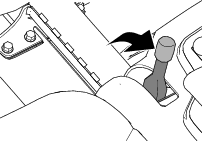
-
Press the traction pedal to move the machine forward.
Note: If the machine moves forward with the parking brake engaged, adjust parking brake; refer to Adjusting the Parking Brake.
Note: Moving the machine forward with the parking brake engaged will cause the engine to shutoff.
-
If you adjusted the parking brake, repeat steps 2 and 3.
Note: If the machine moves forward with the parking brake engaged: service the parking brakes, check left and right brake linkage for damage, and check the brake lever pivot for damage; refer to Servicing the Parking Brakes.
-
Shut off the engine, remove the key, and wait for all moving parts to stop before leaving the operator’s seat.
Positioning the Seat
Changing the Seat Position
The seat can move forward and backward. Position the seat where you have the best control of the machine and are most comfortable
-
To adjust, move the lever sideways to unlock seat (Figure 31).
-
Slide the seat to the desired position and release lever to lock in position.
Changing the Seat Suspension
The seat can be adjusted to provide a smooth and comfortable ride. Position the seat where you are most comfortable.
To adjust it, turn the knob in front either direction to provide the best comfort (Figure 31).
Changing the Back Position
The back of the seat can be adjusted to provide a comfortable ride. Position the back of the seat where it is most comfortable.
To adjust it, turn the knob, under the right-side armrest, in either direction to provide the best comfort (Figure 31).
Changing the Armrest Position
You can adjust the armrests to provide a comfortable ride. Position the armrests where they are most comfortable.
Raise the armrest and turn the knob, in either direction, to provide the best comfort (Figure 31).
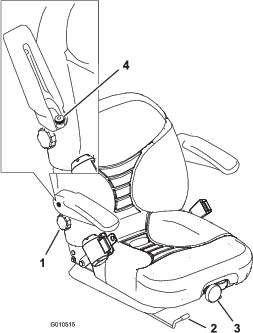
Starting and Stopping the Engine
You may need to bleed the fuel system if any of the following situations have occurred (refer to Bleeding the Fuel System):
-
Initial start up of a new engine
-
The engine has ceased running due to lack of fuel.
-
Maintenance has been performed upon the fuel system components; i.e. filter replaced, etc.
Starting the Engine
-
Be sure that the parking brake is set and the cutting unit drive switch is in the Disengage position.
-
Remove your foot from the traction pedal and make sure that the pedal is in the neutral position.
-
Move the throttle lever to the 1/2 throttle position.
-
Insert the key into the switch and rotate it to the On/Preheat position until the glow-plug indicator light goes out (approximately 7 seconds); then rotate the key to the Start position to engage the starter motor.
Note: Release the key when the engine starts. The key will move automatically to the On/Run position.
Important: To prevent overheating of the starter motor, do not engage the starter longer than 15 seconds. After 10 seconds of continuous cranking, wait 60 seconds before engaging the starter motor again.
-
When the engine is started for the first time or after an overhaul of the engine, operate the machine in forward and reverse for 1 to 2 minutes. Also operate the lift lever and cutting unit drive switch to be sure of proper operation of all parts.
Turn the steering wheel to the left and right to check steering response; then shut the engine off and check for oil leaks, loose parts, and any other noticeable malfunctions.
Caution
Stop the engine and wait for all moving parts to stop before checking for oil leaks, loose parts, and other malfunctions.
Stopping the Engine
Move the throttle control to the Idle position, move the cutting unit drive switch to Disengage, and rotate the starter key to Off. Remove the key from the switch to prevent accidental starting.
Setting the Reel Speed
To achieve a consistent, high quality of cut and a uniform after cut appearance, it is important that you set the reel speed controls (located under the seat) correctly. Adjust the reel speed controls as follows:
-
Select the height of cut at which the cutting units are set.
-
Choose the desired ground speed best suited for conditions.
-
Use the graph on the reel speed chart decal (Figure 32), to determine the proper reel speed setting.

-
To set the reel speed, rotate the knob (Figure 33) until the indicator arrow is in line with the number designating the desired setting.
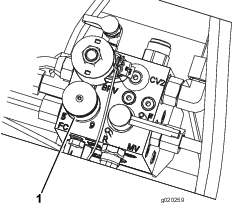
Note: The reel speed can be increased or decreased to compensate for turf conditions. When using baskets, increase the reel speed to improve collection performance.
Adjusting the Lift Arm Counterbalance
You can adjust the counterbalance on the rear cutting unit lift arms to compensate for different turf conditions and to maintain a uniform height of cut in rough conditions or in areas of thatch buildup.
You can adjust each counterbalance spring to one of four settings. Each increment increases or decreases counterbalance on the cutting unit by 1.4 kg (3 lb). The springs can be positioned on the back side of the first spring actuator to remove all counterbalance (forth position).
-
Position the machine on a level surface, lower the cutting units, stop the engine, engage the parking brakes, and remove the key from ignition switch
-
Insert a tube or similar object onto the long spring end to relieve the spring tension during the adjustment (Figure 34).
Caution
The springs are under tension and could cause personal injury.
Use caution when adjusting them.
-
While relieving the spring tension, remove the bolt and locknut securing the spring actuator to the bracket (Figure 34).
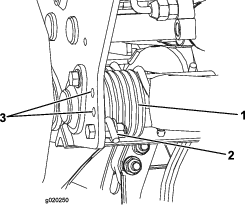
-
Move the spring actuator to the desired hole location and secure it with the bolt and the locknut.
-
Repeat the procedure on the remaining spring.
Bleeding the Fuel System
-
Park the machine on a level surface. Make sure that the fuel tank is at least half full.
-
Unlatch and raise the hood.
Danger
Under certain conditions, diesel fuel and fuel vapors are highly flammable and explosive. A fire or explosion from fuel can burn you and others and can cause property damage.
-
Use a funnel and fill the fuel tank outdoors, in an open area, when the engine is off and is cold. Wipe up any fuel that spills.
-
Do not fill the fuel tank completely full. Add fuel to the fuel tank until the level is 6 to 13 mm (1/4 to 1/2 inch) below the bottom of the filler neck. This empty space in the tank allows the fuel to expand.
-
Never smoke when handling fuel, and stay away from an open flame or where fuel fumes may be ignited by a spark.
-
Store fuel in a clean, safety-approved container and keep the cap in place.
-
-
Open the air-bleed screw on the fuel-injection pump (Figure 35).
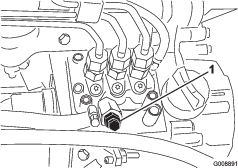
-
Turn the key in the ignition switch to the On position. The electric fuel pump will begin operation, thereby forcing air out around the air-bleed screw.
Note: Leave the key in the On position until a solid stream of fuel flows out around the screw.
-
Tighten the screw and turn the key to Off.
Note: Normally the engine should start after the above bleeding procedures are followed. However, if the engine does not start, air may be trapped between the injection pump and injectors; refer to Bleeding Air from the Injectors.
Understanding the Diagnostic Light
The machine is equipped with a diagnostic light which indicates if the electronic controller senses an electronic malfunction. The diagnostic light is located on the control panel (Figure 36). When the electronic controller is functioning correctly and the key switch is moved to the On position, the controller diagnostic light will turn ON for 3 seconds and turn OFF to indicate the light is working properly. If the machine kills the light will turn on steady until the key position is changed. The light will blink if the controller detects a malfunction in the electrical system. The light will stop blinking and automatically reset when the key switch is turned to the Off position once the fault has been resolved.
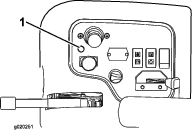
When the controller diagnostic light blinks, one of the following problems has been detected by the controller:
-
One of the outputs has been shorted.
-
One of the outputs is open circuited.
Using the diagnostic display, determine which output is malfunctioning; refer to Checking the Interlock Switches.
If the diagnostic light is not illuminated when the key switch is in the On position, this indicates that the electronic controller is not operating. Possible causes are as follows:
-
Loop-back is not connected
-
The light is burned out.
-
Fuses are blown.
-
It is not functioning correctly.
Check the electrical connections, input fuses, and diagnostic light bulb to determine the malfunction. Ensure that the loop-back connector is secured to the wire harness connector.
Understanding the Diagnostic ACE Display
The machine is equipped with an electronic controller which controls most machine functions. The controller determines what function is required for various input switches (i.e. seat switch, key switch, etc.) and turns on the outputs to actuate solenoids or relays for the requested machine function.
For the electronic controller to control the machine as desired, each of the input switches, output solenoids, and relays must be connected and functioning properly.
Use the Diagnostic ACE display to help verify and correct electrical functions of the machine.
Checking the Interlock Switches
| Maintenance Service Interval | Maintenance Procedure |
|---|---|
| Before each use or daily |
|
The purpose of the interlock switches is to prevent the engine from cranking or starting unless the traction pedal is in the Neutral position, the Enable/Disable switch is in the Disable position, and the Lower Mow/Raise control is in the Neutral position. In addition, the engine should stop when the traction pedal is pressed with operator off of the seat or if the parking brake is left engaged.
Caution
If safety interlock switches are disconnected or damaged the machine could operate unexpectedly causing personal injury.
-
Do not tamper with the interlock switches.
-
Check the operation of the interlock switches daily and replace any damaged switches before operating the machine.
Verifying the Interlock Switch Function
-
Park the machine on a level surface, lower the cutting units, stop the engine, and engage the parking brake.
-
Remove the cover from the control panel.
-
Locate the wire harness and loop-back connector (Figure 37).

-
Carefully unplug the loop-back connector from the harness connector.
-
Connect the Diagnostic ACE display connector to the harness connector (Figure 38).
Note: Make sure correct overlay decal is positioned on Diagnostic ACE display.
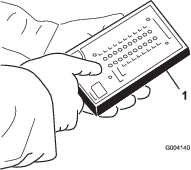
-
Turn the key switch to the On position, but do not start the machine.
Note: The red text on the overlay decal refers to input switches and the green text refers to outputs.
-
The “inputs displayed” LED, on the lower right column of the Diagnostic ACE, should be illuminated. If the “outputs displayed” LED is illuminated, press the toggle button, on Diagnostic ACE, to change LED to “inputs displayed”.
The Diagnostic ACE will illuminate the LED associated with each of the inputs when that input switch is closed.
-
Individually, change each of the switches from open to closed (i.e., sit on seat, engage traction pedal, etc.), and note that the appropriate LED on Diagnostic ACE will blink on and off when corresponding switch is closed. Repeat this for all switches that you can change by hand.
-
If a switch is closed and the appropriate LED does not turn on, check all wiring and connections to the switch and/or check the switches with an ohm meter. Replace any defective switches and repair any defective wiring.
Note: The Diagnostic ACE also has the ability to detect which output solenoids or relays are turned on. This is a quick way to determine if a machine malfunction is electrical or hydraulic.
Verifying Output Function
-
Park the machine on a level surface, lower the cutting units, stop the engine, and engage the parking brake.
-
Remove the access panel from the side of the control arm.
-
Locate the wire harness and connectors near the controller.
-
Carefully unplug the loop-back connector from the harness connector.
-
Connect the Diagnostic ACE connector to the harness connector.
Note: Make sure that the correct overlay decal is positioned on the Diagnostic ACE.
-
Turn the key switch to the On position, but do not start the machine.
Note: The red text on the overlay decal refers to input switches and the green text refers to outputs.
-
The “outputs displayed” LED, on lower right column of Diagnostic ACE, should be illuminated. If the “inputs displayed” LED is illuminated, press the toggle button, on the Diagnostic ACE, to change the LED to “outputs displayed”.
Note: It may be necessary to toggle between “inputs displayed” and “outputs displayed” several times to do the following step. To toggle back and forth, press the toggle button once. This may be done as often as required. Do not hold the button.
-
Sit on the seat and attempt to operate the desired function of the machine. The appropriate output LEDs should illuminate to indicate that the ECM is turning on that function.
Note: If the correct output LEDs do not illuminate, verify that the required input switches are in the necessary positions to allow that function to occur. Verify correct switch function. If the output LEDs are on as specified, but the machine does not function properly, this indicates a non-electrical problem. Repair as necessary.
Note: If each output switch is in the correct position and functioning correctly, but the output LEDs are not correctly illuminated, this indicates an ECM problem. If this occurs, contact your Toro Distributor for assistance
Important: The Diagnostic ACE display must not be left connected to the machine. It is not designed to withstand the environment of the everyday use of the machine. When you are finished using the Diagnostic ACE, disconnect it from the machine and connect the loop-back connector to the harness connector. The machine will not operate without the loopback connector installed on the harness. Store the Diagnostic ACE in a dry, secure location in the shop, not on the machine.
Transporting the Machine
Use a heavy-duty trailer or truck to transport the machine. Ensure that the trailer or truck has all necessary brakes, lighting, and marking as required by law. Please carefully read all the safety instructions. Knowing this information could help you, your family, pets, or bystanders avoid injury.
Warning
Driving on the street or roadway without turn signals, lights, reflective markings, or a slow-moving vehicle emblem is dangerous and can lead to accidents causing personal injury.
Do not drive the machine on a public street or roadway.
To transport the machine:
-
If using a trailer, connect it to the towing vehicle and connect the safety chains.
-
If applicable, connect the trailer brakes.
-
Load the machine onto the trailer or truck.
-
Stop the engine, remove the key, set the brake, and close the fuel valve.
-
Use the metal tie-down loops on the machine to securely fasten the machine to the trailer or truck with straps, chains, cable, or ropes (Figure 39).
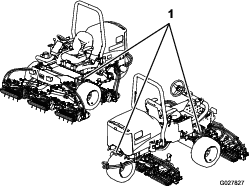
Loading the Machine
Use extreme caution when loading the machine onto a trailer or a truck. One full-width ramp that is wide enough to extend beyond the front tires of the machine is recommended instead of individual ramps for each tire (Figure 40). If it is not possible to use one full-width ramp, use enough individual ramps to simulate a full-width continuous ramp.
The ramp should be long enough so that the angles do not exceed 15 degrees (Figure 40). A steeper angle may cause mower components to get caught as the unit moves from the ramp to the trailer or truck. Steeper angles may also cause the machine to tip backward. If loading the machine on or near a slope, position the trailer or truck so that it is on the down side of the slope and the ramp extends up the slope. This will minimize the ramp angle. The trailer or truck should be as level as possible.
Important: Do not attempt to turn the machine while on the ramp; you may lose control and drive off the side.
Warning
Loading a machine onto a trailer or truck increases the possibility of tipping over and could cause serious injury or death.
-
Use extreme caution when operating a machine on a ramp.
-
Use the ROPS (in up position) while using the seat belt when loading the machine. Ensure that the ROPS clears the top of an enclosed trailer.
-
Use only a single, full-width ramp.
-
If individual ramps must be used, use enough ramps to create an unbroken ramp surface wider than the machine.
-
Do not exceed a 15-degree angle between the ramp and the ground or between the ramp and the trailer or truck.
-
Avoid sudden acceleration or deceleration while driving the machine up or down a ramp.
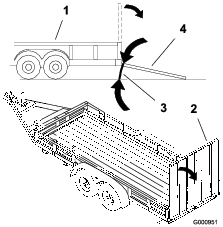
Towing the Machine
In case of an emergency, you can tow the machine for a short distance; however, Toro does not recommend this as a standard procedure.
Important: Do not tow the machine faster than 3 to 4 km/h (2 to 3 mph) because the drive system may become damaged. If the machine must be moved a considerable distance, transport it on a truck or trailer.
-
Locate the bypass valve on the pump (Figure 41) and rotate it 90°.
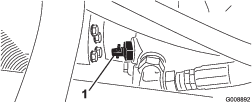
-
Before starting the engine, close the bypass valve by rotating it 90° (1/4 turn).
Important: Do not start the engine when the valve is open.
Operating Tips
General Tips
Becoming Familiar with the Machine
Before mowing grass, practice operating the machine in an open area. Start and stop the engine. Operate in forward and reverse. Lower and raise the cutting units and engage and disengage the reels. When you feel familiar with the machine, practice operating up and down slopes at different speeds.
Danger
When operating the machine, always use the seat belt and ROPS together. Do not use a seat belt without a ROPS.
Understanding the Warning System
If a warning light comes on during operation, stop the machine immediately and correct the problem before continuing operation. Serious damage could occur if you operate the machine with a malfunction.
Mowing Grass
Start the engine and move the throttle to the Fast position. Move the Enable/Disable switch to the Enable position and use the Lower Mow/Raise lever to control the cutting units (the front cutting units are timed to lower before the rear cutting units). To move forward and cut grass, press the traction pedal forward.
Driving the Machine in Transport Mode
Move the Enable/Disable switch to the Disable position and raise the cutting units to the transport position. Move the Mow/Transport lever to the transport position. Be careful when driving between objects so that you do not accidentally damage the machine or the cutting units. Use extra care when operating the machine on slopes. Drive slowly and avoid sharp turns on slopes to prevent roll-overs. Lower the cutting units when going downhill for steering control.
Maintenance
Note: Determine the left and right sides of the machine from the normal operating position.
Recommended Maintenance Schedule(s)
| Maintenance Service Interval | Maintenance Procedure |
|---|---|
| After the first hour |
|
| After the first 10 hours |
|
| After the first 50 hours |
|
| Before each use or daily |
|
| Every 25 hours |
|
| Every 50 hours |
|
| Every 100 hours |
|
| Every 150 hours |
|
| Every 200 hours |
|
| Every 400 hours |
|
| Every 2 years |
|
Caution
If you leave the key in the ignition switch, someone could accidently start the engine and seriously injure you or other bystanders.
Remove the key from the ignition before you do any maintenance.
Service Interval Chart

Pre-Maintenance Procedures
Removing the Hood
The hood may be easily removed to ease maintenance procedures in the engine area of the machine.
-
Unlatch and raise the hood.
-
Remove the hairpin cotter securing the hood pivot to the mounting brackets (Figure 43).
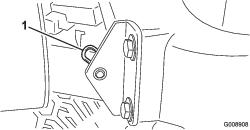
-
Slide the hood to the right side, lift the other side, and pull it out of the brackets.
Note: Reverse the procedure to install the hood.
Removing the Battery Cover
Loosen the knobs and remove the battery cover (Figure 44).
Note: Refer to Servicing for the Battery for more information.
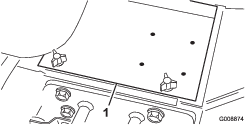
Lubrication
Greasing the Bearings and Bushings
| Maintenance Service Interval | Maintenance Procedure |
|---|---|
| Every 50 hours |
|
The machine has grease fittings that must be lubricated regularly with #2 general-purpose lithium-based grease. Lubricate the bearings and bushings daily when operating conditions are extremely dusty and dirty. Dusty and dirty operating conditions could cause dirt to get into the bearings and bushings, resulting in accelerated wear. Lubricate the grease fittings immediately after every washing, regardless of the interval specified.
The grease fitting locations and quantities are:
-
Steering pivot (Figure 45)
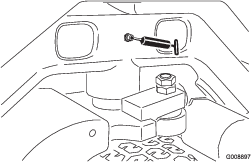
-
Front lift-arm pivots and lift cylinders (3 each); refer to Figure 46.
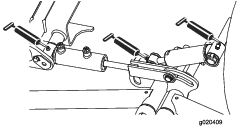
-
Rear lift-arm pivots and lift cylinders (3 each); refer to Figure 47.
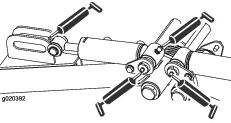
-
Cutting unit pivots (2 each); refer to Figure 48.
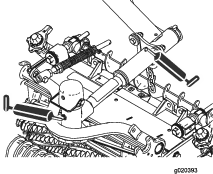
-
Neutral adjust mechanism (Figure 49)
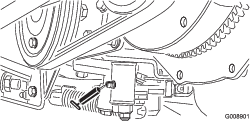
-
Mow/transport slide (Figure 50)
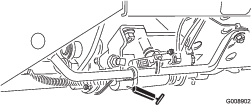
-
Belt tension pivot (Figure 51)
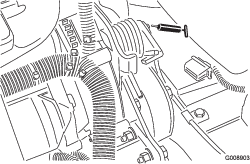
-
Steering cylinder (Figure 52)
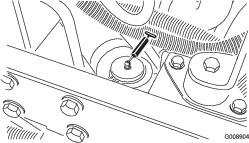
Note: If desired, an additional grease fitting may be installed in the other end of the steering cylinder. Remove the tire, install the fitting, grease the fitting, remove the fitting, and install the plug (Figure 53).
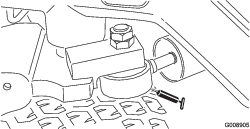
Engine Maintenance
Servicing the Air Cleaner
| Maintenance Service Interval | Maintenance Procedure |
|---|---|
| Every 200 hours |
|
-
Check the air-cleaner body for damage which could cause an air leak. Replace it if it is damaged. Check the whole intake system for leaks, damage, or loose hose clamps.
-
Service the air cleaner at the recommended service interval or earlier if engine performance suffers due to extremely dusty, dirty conditions. Changing the air filter before it is necessary only increases the chance of dirt entering the engine when the filter is removed.
-
Be sure that the cover is seated correctly and seals with the air-cleaner body.
-
Release the latches securing the air-cleaner cover to the air-cleaner body (Figure 54).
-
Remove the cover from the air-cleaner body (Figure 54).
-
Before removing the filter, use low-pressure air (276 kPa [40 psi], clean and dry) to help remove large accumulations of debris packed between outside of primary filter and the canister.
Note: Avoid using high-pressure air which could force dirt through the filter into the intake tract. This cleaning process prevents debris from migrating into the intake when the primary filter is removed.
-
Remove and replace the filter (Figure 54).
Cleaning of the used element is not recommended due to the possibility of damage to the filter media.
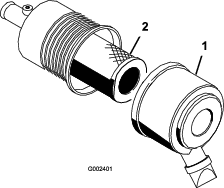
-
Inspect the new filter for shipping damage, checking the sealing end of the filter and the body.
Important: Do not use a damaged element.
-
Insert the new filter by applying pressure to the outer rim of the element to seat it in the canister.
Important: Do not apply pressure to the flexible center of the filter.
-
Clean the dirt-ejection port located in the removable cover.
-
Remove the rubber outlet valve from the cover, clean the cavity and replace the outlet valve.
-
Install the cover orienting the rubber outlet valve in a downward position—between approximately 5:00 to 7:00 when viewed from the end.
-
Secure the cover latches.
Changing the Engine Oil and Filter
| Maintenance Service Interval | Maintenance Procedure |
|---|---|
| After the first 50 hours |
|
| Every 150 hours |
|
-
Remove either drain plug (Figure 55) and let the oil flow into a drain pan. When the oil stops flowing, install the drain plug.
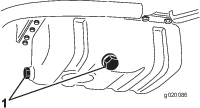
-
Remove the oil filter (Figure 56).
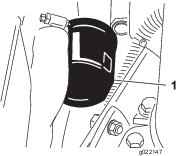
-
Apply a light coat of clean oil to the new filter seal, and install the filter.
Important: Do not overtighten the filter.
-
Add oil to the crankcase; refer to Checking the Engine-Oil Level.
Fuel System Maintenance
Servicing the Fuel Tank
| Maintenance Service Interval | Maintenance Procedure |
|---|---|
| Every 2 years |
|
Drain and clean the tank if the fuel system becomes contaminated or if the machine will be stored for an extended period of time. Use clean fuel to flush out the tank.
Inspecting the Fuel Lines and Connections
| Maintenance Service Interval | Maintenance Procedure |
|---|---|
| Every 400 hours |
|
Inspect the fuel lines and connections for deterioration, damage, or loose connections.
Draining the Water Separator
| Maintenance Service Interval | Maintenance Procedure |
|---|---|
| Before each use or daily |
|
-
Place a clean container under the fuel filter.
-
Loosen the drain valve on the bottom of the filter canister (Figure 57).
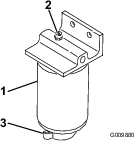
-
Tighten the valve after draining.
Changing the Fuel Filter Canister
| Maintenance Service Interval | Maintenance Procedure |
|---|---|
| Every 400 hours |
|
-
Clean the area where the filter canister mounts (Figure 57).
-
Remove the filter canister and clean the mounting surface.
-
Lubricate the gasket on the filter canister with clean oil.
-
Install the filter canister by hand until the gasket contacts the mounting surface; then rotate an additional 1/2 turn.
Bleeding Air from the Injectors
Note: This procedure should be used only if the fuel system has been purged of air through normal priming procedures and the engine will not start; refer to Bleeding the Fuel System.
-
Loosen the pipe connection to the No. 1 nozzle and holder assembly.
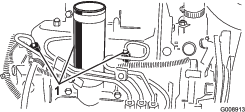
-
Move the throttle to the Fast position.
-
Turn the key in the key switch to the Start position and watch the fuel flow around the connector. Turn the key to the Off position when solid flow is observed.
-
Tighten the pipe connector securely.
-
Repeat the procedure on the remaining nozzles.
Electrical System Maintenance
Servicing for the Battery
| Maintenance Service Interval | Maintenance Procedure |
|---|---|
| Every 25 hours |
|
The battery electrolyte level must be properly maintained and the top of the battery kept clean. lf the machine is stored in a location where temperatures are extremely high, the battery will run down more rapidly than if the machine is stored in a location where temperatures are cool.
Maintain the cell level with distilled or demineralized water. Do not fill the cells above the bottom of the split ring inside each cell. Install the filler caps with the vents pointing to the rear (toward the fuel tank).
Danger
Battery electrolyte contains sulfuric acid which is a deadly poison and causes severe burns.
-
Do not drink electrolyte and avoid contact with skin, eyes or clothing. Wear safety glasses to shield your eyes and rubber gloves to protect your hands.
-
Fill the battery where clean water is always available for flushing the skin.
Keep the top of the battery clean by washing it periodically with a brush dipped in ammonia or bicarbonate of soda solution. Flush the top surface with water after cleaning. Do not remove the filler caps while cleaning.
The battery cables must be tight on the terminals to provide good electrical contact.
Warning
Incorrect battery cable routing could damage the tractor and cables causing sparks. Sparks can cause the battery gasses to explode, resulting in personal injury.
-
Always disconnect the negative (black) battery cable before disconnecting the positive (red) cable.
-
Always connect the positive (red) battery cable before connecting the negative (black) cable.
If corrosion occurs at the terminals, disconnect the cables, negative (–) cable first, and scrape the clamps and terminals separately. Reconnect the cables, positive (+) cable first, and coat the terminals with petroleum jelly.
Warning
Battery posts, terminals, and related accessories contain lead and lead compounds, chemicals known to the State of California to cause cancer and reproductive harm. Wash hands after handling.
Checking the Fuses
The fuses in the electrical system are located under the control panel.
Drive System Maintenance
Adjusting the Traction Drive for Neutral
If the machine moves when the traction pedal is in the neutral position, adjust the traction cam.
-
Park the machine on a level surface and turn the engine off.
-
Raise one front wheel and rear wheel off of the floor and place support blocks under the frame.
Warning
If the machine is not supported adequately, it may accidentally fall, injuring anyone under the machine.
One front wheel and rear wheel must be raised off of the ground or the machine will move during adjustment.
-
Loosen the locknut on the traction adjustment cam (Figure 59).
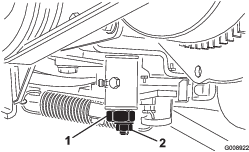
Warning
The engine must be running so a final adjustment of the traction adjustment cam can be performed. Contact with hot or moving parts can result in personal injury.
Keep hands, feet, face, and other body parts away from the muffler, other hot parts of the engine, and other rotating parts.
-
Start the engine and rotate the cam hex in both directions to determine the mid position of the neutral span.
-
Tighten the locknut securing the adjustment.
-
Stop the engine.
-
Remove the support blocks and lower the machine to the shop floor. Test drive the machine to make sure that it does not move when the traction pedal is in neutral.
Cooling System Maintenance
Cleaning the Engine Cooling System
| Maintenance Service Interval | Maintenance Procedure |
|---|---|
| Before each use or daily |
|
Remove debris from the radiator/oil cooler daily. Clean them more frequently in dirty conditions.
-
Turn the engine off and raise the hood. Clean the engine area thoroughly of all debris.
-
Clean both sides of the radiator/oil cooler thoroughly with compressed air (Figure 60).

-
Close the hood.
Brake Maintenance
Adjusting the Parking Brake
| Maintenance Service Interval | Maintenance Procedure |
|---|---|
| Every 200 hours |
|
-
Loosen the setscrew securing the knob to the parking-brake lever (Figure 61).
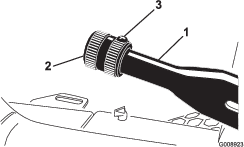
-
Rotate the knob until a force of 133 to 178 N (30 to 40 lb) is required to actuate the lever.
-
Tighten the setscrew after the adjustment has been attained.
Servicing the Parking Brakes
| Maintenance Service Interval | Maintenance Procedure |
|---|---|
| Every 400 hours |
|
Preparing the Machine
-
Park machine on a level surface, engage parking brake, lower cutting units, shut off the engine, remove the key, and wait for all moving parts to stop before leaving the operator’s seat.
-
Raise the front of machine.
-
Support the machine with jack stands rated for the weight of your machine; refer to Specifications.
-
Repeat steps 2 and 3 at the other side of the machine.
Removing the Front Wheels
-
Remove the 4 lug nuts that secure the front wheel to the hub, and remove the wheel (Figure 62).
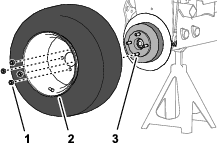
-
Repeat step 1 at the other side of the machine.
Removing the Wheel Hub and Brake Drum
Special Tools: Wheel Hub Puller—Toro Part No. TOR4097
-
Remove the locknut that secures the hub to the wheel-motor shaft (Figure 63 or Figure 64).
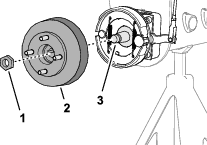
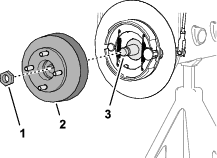
-
Repeat step 1 at the other side of the machine.
-
Release the parking brake.
-
Use the specified wheel hub puller to remove wheel hub and brake drum from the wheel-motor shaft (Figure 63 or Figure 64).
-
Remove woodruff key from the wheel-motor shaft (Figure 65).
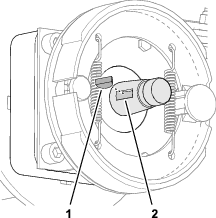
-
Repeat steps 4 and 5 at the other side of the machine.
Cleaning the Brake Drum and Shoes
At both sides of the machine, clean inside the brake drums, the brake shoes, backing plate (Figure 66) , and when installed, the optional grass shield of any grass, dirt, and dust.

Inspecting and Lubricating the Brake Cam Shaft
-
At the inboard side of the brake-backing plate (machines without the optional wheel-rim grass shield) or the wheel shield (machines with the optional wheel-rim grass shield), spray penetrating oil between the brake cam shaft and the backing plate (Figure 67 or Figure 68).
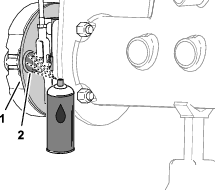
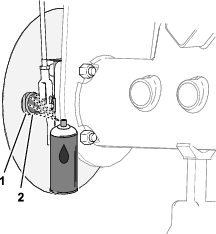
-
Move the parking brake lever up and down to check that the lever for the brake-cam lever moves freely (Figure 69).
Note: If the brake cam binds, repair or replace the brake cam; refer to the Service Manual for your machine.
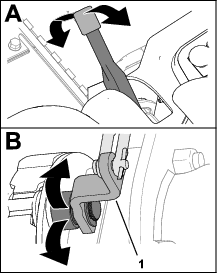
-
Repeat steps 1 and 2 at the other side of the machine.
-
Move the parking brake lever down (the disengaged position).
Inspecting the Brake Linkage
-
Inspect the left and right brake-rod assemblies (Figure 70) for damage and wear.
Note: If the brake rod parts are damaged and worn, replace them; refer to the Service Manual for your machine.
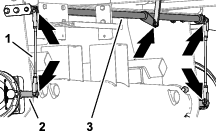
-
Inspect the brake pivot shaft (Figure 70) for damage and wear.
If the pivot shaft is damaged and worn, replace them; refer to the Service Manual for your machine.
Installing the Wheel Hub and Brake Drum
-
Thoroughly clean the wheel hub and hydraulic motor shaft.
-
Insert the woodruff key into the groove of the wheel-motor shaft (Figure 71).

-
Assemble the wheel hub and brake drum onto the wheel-motor shaft (Figure 72 or Figure 73).


-
Secure the wheel hub to the shaft with the locknut (Figure 72 or Figure 73), and tighten by hand.
Note: The brake shoes and backing plate must concentrically align with the brake drum. If the shoes, plate, and drum are misaligned, refer to the Service Manual for your machine.
-
Repeat steps 1 through 4 at the other side of the machine.
Installing the Wheel
-
Assemble the wheel to the hub with the 4 lug nuts (Figure 74), and tighten the lug nuts by hand.

-
Repeat step 1 at the other side of the machine.
-
Remove the jack stands and lower the machine.
-
Torque wheel lug nuts to 95 to 122∙Nm (70 to 90 ft-lb) in a crossing pattern.
-
Torque the locknut is to 339 to 372 N∙m (250 to 275 ft-lb).
-
Check parking brake and adjust it if necessary; refer to Checking the Parking Brake.
Belt Maintenance
Servicing the Engine Belts
| Maintenance Service Interval | Maintenance Procedure |
|---|---|
| After the first 10 hours |
|
| Every 100 hours |
|
Tensioning the Alternator/Fan Belt
-
Open the hood.
-
Check the belt tension by depressing the belt midway between the alternator and crankshaft pulleys.
Note: With 98 N (22 lb) of force, the belt should deflect 11 mm (7/16 inch).
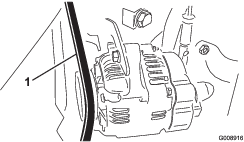
-
If the deflection is incorrect, complete the following procedure to tension the belt:
-
Loosen the bolt securing the brace to the engine and the bolt securing the alternator to the brace.
-
Insert a pry bar between the alternator and engine and pry out on the alternator.
-
When the proper tension is achieved, tighten the alternator and brace bolts to secure the adjustment.
-
Replacing the Hydrostat Drive Belt
-
Insert a nut driver or small piece of tubing onto the end of the belt tensioning spring.
Warning
The spring is under a heavy load and could cause personal injury
Use caution when de-tensioning the spring.
-
Push down and forward on the spring end (Figure 76) to unhook it from the bracket and release tension on the spring.
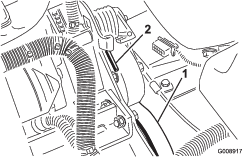
-
Replace the belt.
-
Reverse the procedure to tension the spring.
Controls System Maintenance
Adjusting the Throttle
-
Position the throttle lever rearward so it stops against the control panel slot.
-
Loosen the throttle cable connector on the injection pump lever arm (Figure 77).
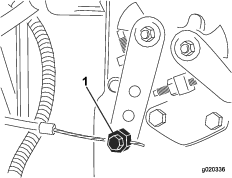
-
Hold the injection pump lever arm against the low idle stop and tighten the cable connector.
-
Loosen the screws securing the throttle control to the control panel.
-
Push the throttle control lever all of the way forward.
-
Slide the stop plate until it contacts the throttle lever and tighten the screws securing the throttle control to the control panel.
-
If the throttle does not stay in position during operation, torque the locknut, used to set the friction device on the throttle lever, to 5 to 6 N-m (44 to 53 inch-lb).
Note: The maximum force required to operate the throttle lever should be 89 N (20 lb).
Hydraulic System Maintenance
Changing the Hydraulic Filter
| Maintenance Service Interval | Maintenance Procedure |
|---|---|
| After the first 10 hours |
|
| Every 200 hours |
|
Use a genuine Toro replacement filter, Part 86-3010.
Important: Use of any other filter may void the warranty on some components.
-
Position the machine on a level surface, lower the cutting units, stop the engine, engage the parking brake, and remove the key from the ignition switch.
-
Clean around the filter mounting area. Place a drain pan under the filter (Figure 78) and remove the filter.
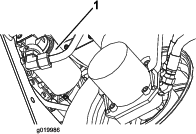
-
Lubricate the new filter gasket and fill the filter with hydraulic fluid.
-
Ensure that the filter mounting area is clean. Screw the filter on until the gasket contacts the mounting plate; then tighten the filter 1/2 turn.
-
Start the engine and let it run for about 2 minutes to purge air from the system. Stop the engine and check for leaks.
Changing the Hydraulic Fluid
| Maintenance Service Interval | Maintenance Procedure |
|---|---|
| Every 400 hours |
|
If the fluid becomes contaminated, contact your local Toro distributor because the system must be flushed. Contaminated fluid looks milky or black when compared to clean oil.
-
Position the machine on a level surface, lower the cutting units, stop the engine, engage the parking brake, and remove the key from the ignition switch.
-
Disconnect the large hydraulic hose (Figure 79) from the reservoir and let the hydraulic fluid flow into a drain pan.
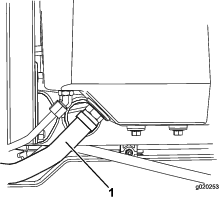
-
Install the hydraulic hose when hydraulic fluid stops draining.
-
Fill the reservoir (Figure 80) with approximately 13.2 liters (3.5 US gallons) of hydraulic fluid; refer to Checking the Hydraulic System.
Important: Use only the hydraulic fluids specified. Other fluids could cause system damage.

-
Install the reservoir cap. Start the engine and use all of the hydraulic controls to distribute the hydraulic fluid throughout the system.
-
Check for leaks; then stop the engine.
-
Check the fluid level and add enough to raise the level to Full mark on the dipstick.
Important: Do not overfill the reservoir.
Checking the Hydraulic Lines and Hoses
| Maintenance Service Interval | Maintenance Procedure |
|---|---|
| Before each use or daily |
|
Check the hydraulic lines and hoses for leaks, kinked lines, loose mounting supports, wear, loose fittings, weather deterioration, and chemical deterioration. Make all necessary repairs before operating.
Warning
Hydraulic fluid escaping under pressure can penetrate skin and cause injury.
-
Make sure all hydraulic fluid hoses and lines are in good condition and all hydraulic connections and fittings are tight before applying pressure to the hydraulic system.
-
Keep your body and hands away from pin hole leaks or nozzles that eject high pressure hydraulic fluid.
-
Use cardboard or paper to find hydraulic leaks.
-
Safely relieve all pressure in the hydraulic system before performing any work on the hydraulic system.
-
Seek immediate medical attention if fluid is injected into skin.
Cutting Unit System Maintenance
Using the Optional Gauge Bar
Use the gauge bar (Figure 81) to adjust the cutting unit. Refer to the Cutting Unit Operator's Manual for the adjustment procedures.
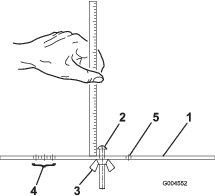
Backlapping the Cutting Units
Warning
Contact with the reels or other moving parts can result in personal injury.
-
Keep fingers, hands, and clothing away from the reels or other moving parts.
-
Never attempt to turn the reels by hand or foot while the engine is running.
Note: When backlapping, all the cutting units operate together.
-
Position the machine on a level surface, lower the cutting units, stop the engine, engage the parking brake, and move the Enable/Disable switch to disable position.
-
Raise the floor panel to expose the controls.
-
Make the initial reel to bedknife adjustments appropriate for backlapping; refer to the cutting unit Operator's Manual
-
Start the engine and allow it to run at low idle speed.
Danger
Changing the engine speed while backlapping may cause the reels to stall.
-
Never change the engine speed while backlapping
-
Only backlap at idle engine speed.
-
-
Set the reel speed control to position 1 (Figure 82).
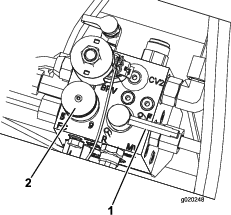
-
Move the backlap lever to the R (backlap) position (Figure 82).
Danger
Contacting the reels when they are moving could cause personal injury.
To avoid personal injury, be certain that you are clear of the cutting units before proceeding.
-
With the Mow/Transport lever in the mow position, move the Enable/Disable switch to the Enable position. Move the Lower Mow/Lift control forward to start the backlapping operation on the designated reels.
-
Apply lapping compound with a long handle brush. Never use a short handled brush.
-
If the reels stall or become erratic while backlapping, select a higher reel speed setting until the speed stabilizes, then return the reel speed to setting 1 or to your desired speed.
-
To make an adjustment to the cutting units while backlapping, turn the reels off by moving the Lower Mow/Raise lever rearward; the Enable/Disable switch to the Disable position, and stop the engine. After completing adjustments, repeat steps 5 through 9.
-
Repeat the procedure for all the cutting units that you want to backlap.
-
When you are finished, return the backlap lever to the Mow position, lower the floor panel, and wash all lapping compound off of the cutting units. Adjust the cutting unit reel-to-bedknife contact as needed. Move the cutting unit reel speed control to the desired mowing position.
Important: If the backlap switch is not returned to the F (Mow) position after backlapping, the cutting units will not raise or function properly.
Note: For a better cutting edge, run a file across the front face of the bedknife after lapping. This will remove any burrs or rough edges that may have built up on the cutting edge.
Storage
Storing the Battery
If the machine will be stored more than 30 days, remove the battery and charge it fully. Store the battery in a cool atmosphere to avoid quick deterioration of the charge in the battery. To prevent the battery from freezing, make sure that it is fully charged. The specific gravity of a fully charged battery is 1.265–1.299.
Preparing the Machine for Seasonal Storage
Follow these procedures anytime you will be storing the machine for more than 30 days.
Preparing the Traction Unit
-
Thoroughly clean the traction unit, the cutting units, and the engine.
-
Check the tire pressure. Inflate all tires to 83 kPa (12 psi).
-
Check all fasteners for looseness; tighten as necessary.
-
Grease or oil all grease fittings and pivot points. Wipe up any excess lubricant.
-
Lightly sand and use touch-up paint on painted areas that are scratched, chipped, or rusted. Repair any dents in the metal body.
-
Service the battery and cables as follows:
-
Remove the battery terminals from the battery posts.
-
Remove the battery.
-
Slowly recharge the battery before storage and every 60 days thereafter for 24 hours to prevent lead sulfation of the battery.
To prevent the battery from freezing, make sure it is fully charged. The specific gravity of a fully charged battery is 1.265–1.299.
-
Clean the battery, terminals, and posts with a wire brush and baking soda solution.
-
Coat the cable terminals and battery posts with Grafo 112X skin-over grease (Toro Part 505-47) or petroleum jelly to prevent corrosion.
-
Either store it on the shelf or on the machine in a cool area. Leave the cables disconnected if it is stored on the machine.
-
Preparing the Engine
-
Drain the engine oil from the oil pan and replace the drain plug.
-
Remove and discard the oil filter. Install a new oil filter.
-
Refill the oil pan with approximately 3.8 liters (4 US qt) of SAE 15W-40 motor oil.
-
Start the engine and run it at idle speed for approximately 2 minutes.
-
Stop the engine.
-
Thoroughly drain all fuel from the fuel tank, fuel lines, fuel filter, and water separator assembly.
-
Flush the fuel tank with fresh, clean diesel fuel.
-
Secure all fuel system fittings.
-
Thoroughly clean and service the air-cleaner assembly.
-
Seal the air-cleaner inlet and the exhaust outlet with weatherproof tape.
-
Check the anti-freeze protection and add antifreeze/coolant as needed for the expected minimum temperature in your area.